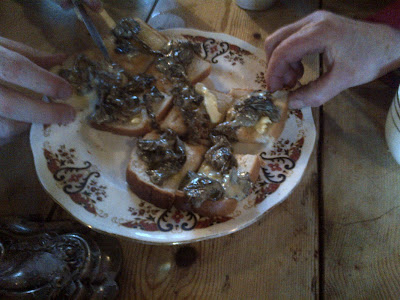Gareths mushrooms fried up on hot buttered toast...Yum
Foraging in the Woodlands
Gareth Austin, our own Radio Foyle gardener, community
horticultural activist and Buncrana Tidy Towns Gardening competition judge, set
up a mushroom forage around Prehen House in Derry recently. With the help of
fungi expert Colin Peck, the small group gathered a wide range of fungi from
the bold and beautiful to the strange and bizarre into baskets ready to be
identified to see if they were edible varieties.
The group had to be limited in numbers as their woodland
autumn harvest was cooked up at the end of the day then spread on delicious hot
buttered toast. The positive comments
and popularity of the day prompted Gareth to set another day to cater for the
demand at the end October, check out
Gareth’s website or
facebook page to see if there are any more ‘Gatherings ‘ before the end of the
season. It’s a wonderful thing to have
the knowledge and confidence to safely eat what comes out of the woods and it
is recommended that you only eat mushrooms that you know are not poisonous.
Having an expert team on hand as this course does save you any mishaps and
visits to the poisons unit at the hospital.
How to avoid mushroom
poisoning
Shelley Evans'
guidelines in "Guides for the Amateur Mycologist “have been helpful with
this list.
1. Unfamiliar Species: Check and re-check your
identification, especially looking out for a similar poisonous species. If
still in doubt, ask an expert or throw it away.
2. Examine each specimen. Always check each specimen in case
a different species has got in amongst your collection of edible ones.
3. Keep your collections separate. Do not mix edible and
non-edible species in a collecting tray if you are collecting for the pot. It
is a good idea if collecting for the pot to only collect edible species and not
other species for identification purposes.
4. Check the spore print. A simple operation, leaving a cap
on some paper and covering for an hour or so. This will help check your
identification.
5. Do not eat raw wild fungi. Some wild fungi are poisonous
if eaten raw, e.g. Wood Blewit, Lepista nuda, the Blusher, Amanita rubescens or
species of Helvella. Always cook your collections.
6. Retain an uncooked specimen. This is a very sensible
idea. Keep one example of what you have eaten in the fridge. In case, you do
poison yourself, this will help others identify what you have eaten and
therefore know how to treat you. Different species contain different toxins,
therefore treatments will vary.
7. Only eat good specimens. Many poisoning cases occur when
edible species are eaten in poor condition. Only eat good specimens!
8. Keep your collections in the fridge. This keeps your
specimens in good condition.
9. Experimenting. If experimenting and eating a type for the
first time, only eat a small amount. Different people react to fungi in
different ways and it is safer to test your own body out gently!
10. Alcohol. Avoid drinking alcohol with species you haven't
eaten before and with certain species, e.g. the Common Ink Cap, Coprinus
atramentarius.
11. Fear. Do not feed wild mushrooms to people who don't
want to eat them. Fear can make people sick.
12. Susceptible people. Do not serve wild fungi to young
children, old or sick people. Their resistance may be lower.
13. Greed. Do not large quantities of wild mushrooms in one
sitting. This alone can make you sick.
Remember : There’s not substitute for an expert by your side.
Successful Sunflowers
We had a very successful sunflower harvest this year. They weren’t competition winners by any
stretch of the imagination, only growing to about seven feet. But that means
that the heads are full of plump seeds. The current world record for the
tallest sunflower is just a touch over 26 feet, held by a bloke in Germany.
Because our plants were quite compact and big headed we didn’t need to stake
them and stood up on their own for most of the summer. They have drooped a bit in their old age, but
that’s to be expected when the heads mature and get top heavy.
Get them first
We have grown a fair amount of sunflowers in the past and
it’s usually the birds or fungal disease that gets to the seeds before we do so
this year I was ahead of the game and cut them down just as the yellow petals
dropped off. Text books tell us to wait
until the rear of the flower turns brown before chopping the stems off to about
a foot in length, I find this is beyond the point of no return as they just rot. Mine are still green and lush so hanging them
in a warm dry place should do the trick.
Another suggestion is leaving the flower heads on the plants and
covering them with a paper bag to protect them from the birds. The
recommendations are to change the bag ‘should it rain and get the bags
wet’. As I don’t want to change the bags
3 times I day, I’ll give that method a miss thank you.
The seeds are remarkably plump and well formed so I think
this year will be a successful crop.
It’d be nice to have grown enough to produce my own sunflower oil but
I’ll settle for a few seeds scattered on my porridge in the mornings.


No comments:
Post a Comment